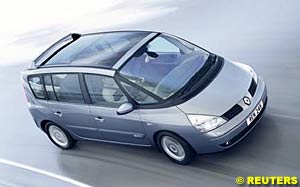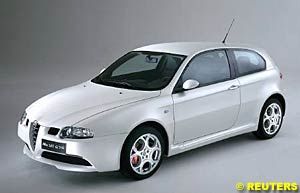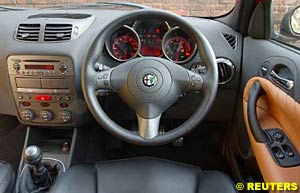

Automotive News and Reviews for the Petrolhead
Reuters Motoring Commentator
In this week's issue:
- A Family Affair with Renault's Espace
- Heart Rules Head with Alfa's 147 GTA
Children are a bit like pints of beer.
You have one and all seems well with the world but one, almost inevitably, leads to two. Two can quickly become three and so it goes on. The problem is, before you know it, too much of a good thing can leave you bursting for an MPV (or people carrier, as they are now more commonly known).
Back in 1984 the French maker Renault launched its automotive accompaniment to the rhythm method, the Espace. Often hailed as the world's first 'people carrier' (it wasn't - the Chrysler Voyager was in 1983), Renault's original was a clever compromise between the familiar passenger saloon and a minibus. It instantly created an entire new market sector. In its first year Renault sold a fairly insubstantial 5,745 of them but a decade on and the annual figure had increased to 66,000. Today the total MPV market is worth in excess of 300,000 vehicles per annum.
Earlier this year Renault launched the fourth generation of its original concept, seeking to once again raise the bar. The range is comprised of two principal models, Espace and Grand Espace, with the main difference being 20cm in overall length. There are four trim levels compared with three for Grand Espace Authentique, Expression, Privilege and Initiale. The entry level 2.0 16V Espace Authentique costs a sensible £19,130, in return for which you get seven individual seats, split-cabin air conditioning, electric windows all round and an in-dash CD player. Its 140bhp engine and six-speed manual gearbox combine to provide a 115mph top speed and impressive 30+ mpg (combined cycle).
The Key to Security
All models benefit from latest generation Renault safety features, including three different kinds of airbags - adaptive, curtain and lateral - ABS anti-lock brakes, electronic stability programme and the latest in engine immobility and security. This feature incorporates Renault Card, instead of a conventional key, which opens and locks the car and is also inserted into a console-mounted reader, allowing you to then start the car via a push button. This card also stores a variety of diagnostic information that helps the car's software memorise service intervals, tyre pressures and various driver ergonomic settings.
Low-Level Navigation
The list is extensive and the car is certainly an ergonomic joy to drive, save for one feature. In most models, the Carminat satellite navigation is a £1,500 option and it works well, but why has Renault sited the controls on the floor (nearly)? I've got long arms but the elevated seating position of the Espace left even me stretching and groping to successfully operate the controls.
Of course, for many people the problems with an MPV begin way before you slip behind the wheel. It's the way they look. There are those who view the people carrier as a motoring nadir; a concession too far in the battle to balance family practicality with "kids-won't-change-me" individuality. Undeniably, the functionality of these cars has always leant them a certain van-like look; they have always been practical first and pretty a very distant second.
But not any more. The Espace has been on the road for three months now and it still turned heads everywhere I went. This fourth generation version bucks the general trend with its shorter front and rear overhangs, purposeful tapered styling and futuristic exterior detailing. Perhaps for the first time, here is an MPV with a dignity and posture all its own which, in turn, affords it a sense of quality and style not previously associated with such a vehicle. In short, the Espace is a smart looking vehicle and once you have travelled in it, it seems a whole lot smarter still.
Smooth Ride
This car offers levels of refinement that are unprecedented in a people carrier and at motorway speeds, the car is uncannily quiet and smooth. Renault's ambition for Espace IV is that it offers an alternative to a luxury saloon and this is perfectly plausible. Over and above the ride-quality (and absence of any discernible engine or wind noise), the practicalities of the cabin are matched by outstanding levels of equipment. Overall, the new Espace offers a real sense of being designed to make travel as enjoyable as possible. It offers exceptional all-round visibility, a full-length panoramic electric glass sunroof (optional on most models), integrated rear passenger sun blinds, that clever climate control with individual passenger adjustment and the choice of a six-speed manual or five-speed automatic transmission with manual 'flick-shift' sequential setting.
Not that a sequential gearbox would ordinarily be deemed an essential item in the standard specification of an MPV. Traditionally, another black mark against the people carrier has been the general lack of any real driving appeal. In the same way that the function largely determines the form, so the handling and performance are dictated by similar constraints. By definition, a people carrier is an awkward mass to shift and yet even the Grand version of the new Espace proved anything but unwieldy. The customary MPV tendency to understeer and float through corners is much less in evidence and both the petrol and turbo-diesel V6 models return impressive performance figures. Renault claims its new Espace to be the most powerful MPV in its class although with a total of seven different trim/model variants and five engine options, it is unclear which one they mean.
No matter, because overall the latest Espace presents a compelling argument in favour of this type of vehicle. It is spacious, refined, clever, quiet, over 90% recyclable (by weight) and comes complete with that trademark sense of vivacity that is such a feature of Renault's relentless marketing. And if you do need an excuse, I'd say it's even worth planning a big family for.
Alfa Romeo and parent company Fiat may be struggling to get their books out of the red as poor sales and high costs continue to beset the Italians. But a racy Alfa is all but guaranteed to leave all the problems behind when red turns to green at the traffic lights.
The Gran Turismo Alleggerita, "lightened Grand Tourer," moniker first appeared in the 1960s on race-prepared Giulia Sprint Touring cars, which dominated the European Touring Car Championships over the next decade and more. The 156 GTA has continued the tradition by winning the same competition over the last couple of years.
The 147 has been reworked to accommodate a throbbing 3.2-litre V6 engine under the bonnet and deliver up even more throaty performance. Is this Alfa worthy of the GTA badge, and just as importantly, is it worthy of a price tag of £22,500 - way above most other hot hatches?
Run With It
Most hot hatches have four-cylinder engines, often using turbochargers to extract the most out of them. That's what Ford has done with its manic Focus RS. Alfa goes one up with a six-cylinder engine - and it's a complete winner. The 3.2-litre V6 is not only the best engine in Alfa's entire range, it is also quite possibly the best six-cylinder engine made anywhere in the world. It's almost a shame that the bonnet hides this Da Vinci of an engine - while the trend is for sealed-in-plastic engine bays, the GTA revels in a chromed exhaust extravaganza.
The quad-cam 3.2-litre V6 boasts a massive 250bhp - as a benchmark, the Focus RS has only 220bhp. Because it doesn't need a turbo, as soon as you put your foot down there is instant access to vast reserves of power. Even at low engine speeds, the delivery is smooth and instantaneous. Power peaks at 6200 rpm, so there is plenty of room for enjoyment right across the rev range. And as for the sound it makes, Mozart on acid couldn't have done a better job.
With a 0-60 mph time of just 6.3 seconds, the GTA is comfortably quicker off the mark than any other hot hatch, including the £25,000 Audi S3. And thanks to a super-slick close-ratio six-speed gearbox, upgraded especially for the GTA, in-gear acceleration is also class-leading although the gearbox is rather imprecise.
Putting so much power through the front wheels was always going to be a major challenge. It's almost impossible not to lose grip on full throttle, despite fat tyres and a monster traction control system that includes ABS, EBD (electronic brake distribution), VDC (vehicle dynamic control), ASR (anti-slip regulation) and MSR (motor slip regulation). You can tell just how much Alfa had to do to contain everything.
The trouble is, it simply can't do the job. Take a corner quickly and you suddenly have armfuls of understeer to try and correct. Torque steer (that's when the steering wheel decides it wants to go in an unplanned direction when you apply the accelerator) reaches new levels of absurdity. One moment you're happily going where you want, the next you're trying to rein the bull in by its horns. You certainly need the Alfa's light, super-quick steering just to keep on top of it. The GTA's saving grace is that its torque steer is not quite as severe as the Focus RS.
Braking is up to the job thanks to massive red-painted Brembo four-pot callipers with electronic brake distribution. And equipment levels are impressive, including standard cruise control, dual zone climate control, Bose sound system, heated mirrors, gorgeous 17-inch alloys and an aero bodykit.
Rip Up the Rule Book
If the Focus RS's interior is an exercise in cost-cutting, the GTA's is like the inside of a no-expense-spared Italian couturier's handbag. Hand-stitched leather on our test car is an £850 option but so delicious that it's hard to resist.
So is it worth the asking price? It's almost an irrelevant question. If you go by the normal rules, you'd buy a Ford Focus RS instead and save £2500. But if you buy an Alfa GTA, you're ripping up the rulebook. This is a wild child you buy with the heart, not the head. It's a poetic statement, nothing less.
![]() A Family Affair with Renault's Espace
A Family Affair with Renault's Espace
 Ergonomics have long been high on Renault's list of priorities. This is the company that first introduced the steering column-mounted audio control and Renault is certainly one of the world's bolder design-led innovators. The new Espace is laden with clever gadgets and practical touches, all designed to help move between one and seven people around as safely and comfortably as possible. A touch-free parking brake that automatically engages when the engine is switched off, and disengages when the accelerator is pressed, is a first in this sector. Every seat has an integrated inertia-reel seat belt and each passenger benefits from separate adjustable air-conditioning outlets. Filling up no longer involves unscrewing anything: simply pop open the filler flap and insert the nozzle. The Espace has always been littered with commodious storage bins, flaps and holes and the new generation model is no exception.
Ergonomics have long been high on Renault's list of priorities. This is the company that first introduced the steering column-mounted audio control and Renault is certainly one of the world's bolder design-led innovators. The new Espace is laden with clever gadgets and practical touches, all designed to help move between one and seven people around as safely and comfortably as possible. A touch-free parking brake that automatically engages when the engine is switched off, and disengages when the accelerator is pressed, is a first in this sector. Every seat has an integrated inertia-reel seat belt and each passenger benefits from separate adjustable air-conditioning outlets. Filling up no longer involves unscrewing anything: simply pop open the filler flap and insert the nozzle. The Espace has always been littered with commodious storage bins, flaps and holes and the new generation model is no exception.
![]() Heart Rules Head with Alfa's 147 GTA
Heart Rules Head with Alfa's 147 GTA
 In the past, when the financial future of the company looked more secure, Alfa Romeos were afflicted with dire reliability problems that put off too many drivers of BMWs and the like. Now Alfa Romeo has addressed most of the problems and is undergoing a sporting renaissance by reintroducing its famous GTA badge, first on the 156 and now on the 147.
In the past, when the financial future of the company looked more secure, Alfa Romeos were afflicted with dire reliability problems that put off too many drivers of BMWs and the like. Now Alfa Romeo has addressed most of the problems and is undergoing a sporting renaissance by reintroducing its famous GTA badge, first on the 156 and now on the 147.
 Unfortunately, when it comes to corners the 147 chassis struggles to contain all that power. The suspension is based on the ordinary 147, itself modelled on the 156. While it's considerably better than the bigger 156 GTA, the nose seems to have a mind of its own, and that mind belongs to a wild, bucking bronco.
Unfortunately, when it comes to corners the 147 chassis struggles to contain all that power. The suspension is based on the ordinary 147, itself modelled on the 156. While it's considerably better than the bigger 156 GTA, the nose seems to have a mind of its own, and that mind belongs to a wild, bucking bronco.
© 1995-2005 Kaizar.Com, Inc. . This service is provided under the Atlas F1 terms and conditions.
|
Volume 9, Issue 24
Atlas F1 Exclusive
Interview with Eddie Jordan
Giancarlo Fisichella: Through the Visor
Articles
Season in the Sun IV
The Dream Team Rolls On
Canadian GP Preview
Canadian GP Preview
Canada Stats and Facts
Columns
The F1 Trivia Quiz
The Fuel Stop
Bookworm Critique
On the Road
Elsewhere in Racing
The Weekly Grapevine
> Homepage |